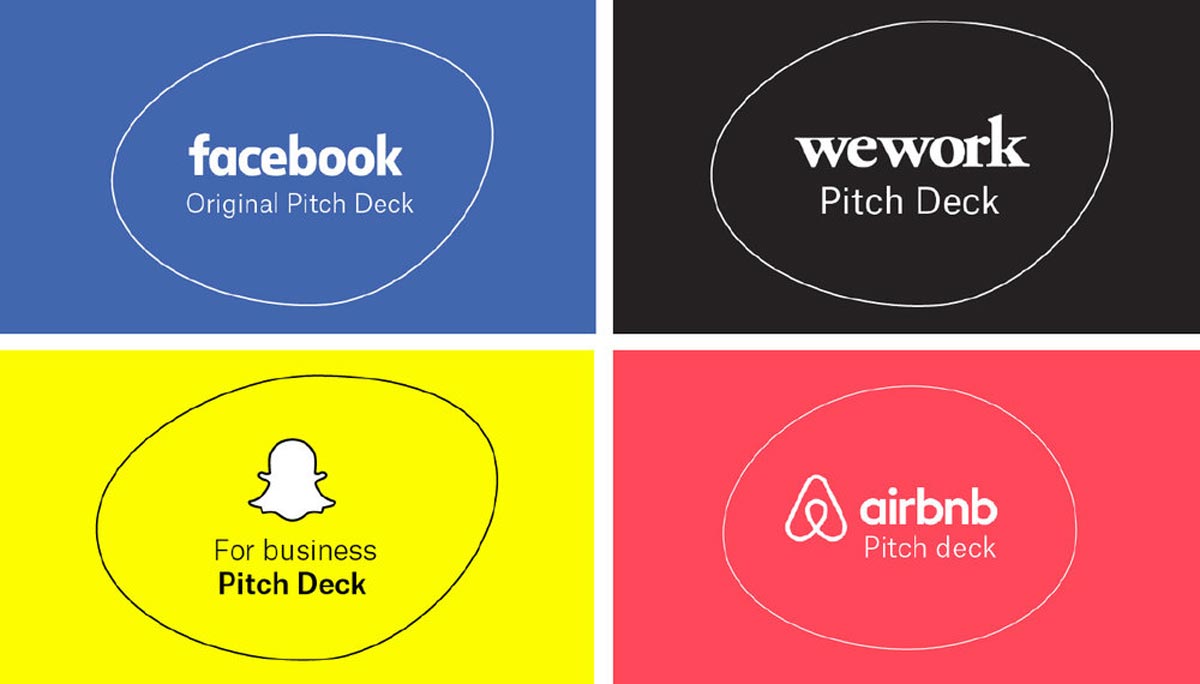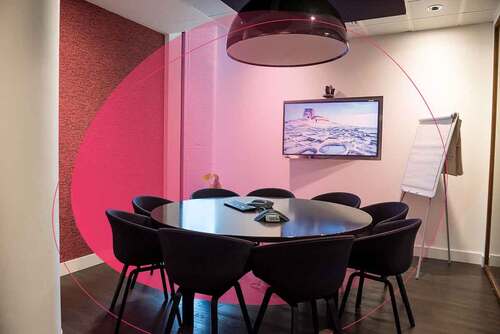Nabeel Alamgir's journey from busboy to startup founder is a living example that startup life is an authentic rollercoaster.
After being turned down by more than 70 investors, his brainchild, Lunchbox, raised some serious capital to compete against the big dogs like GrubHub and Uber Eats in the food-tech world.
Starting with $2 million in seed capital, Lunchbox even caught the eye of Doordash for a potential buyout before their seed round was secured. But Alamgir and his co-founder Andrew Boryk decided to embark on the journey themselves and bet big on their own dream.
This article will analyze the pitch deck Lunchbox used to land their seed round. (By the way, we recently redesigned and added it to our pitch deck templates)
First, we need to understand a pitch deck: it's more than just a presentation; it's a story that sells your vision, aiming to build trust and investment interest.
Let’s analyze the overall story arc from Lunchbox’s deck:
- Cover
- Problem
- Solution
- Product / How it Works
- Features
- Features
- Product (Marketplace) and Business Model / USP / Roadmap
- Expansion / Roadmap
- Partner Funnel / Traction
- Competition
- Competition
- Market Validation
- Market Validation
- Team
- Secret Sauce
- TAM
- Business Model
At Slidebean, we specialize in creating tailored pitch decks. We’ve been perfecting a general story structure that we believe most decks should follow.

While the deck has a couple of exceptions, the overall story flow does stick to the structure established by Slidebean.
Let’s analyze each slide of the deck:
1 - Cover Slide

This is your deck's first impression, so make it count. Stick to your company's name, logo, and a catchy tagline that's no longer than a tweet. It's your chance to grab attention without saying a word. Think of it as the headline of your startup's story.
2- Problem

Nailing the problem slide can be difficult. It's all too easy to either overdo it or start venturing into solution territory.
The best approach? Focus on the core issue your company solves. Go for clarity, conciseness, and undeniable facts, all backed by data.
This particular slide could do with less text for my taste. Ideally, spotlight one main problem, supported by the different bullet points. That said, it scores well on providing data-backed clarity and objective stametements (the bold titles). Good start to the deck.
3 - Solution

This slide introduces us to Lunchbox, "the Shopify for restaurants," but it also brings in elements that should ideally be on separate slides, like outlining the current fragmented and costly restaurant solution landscape.
A clearer approach might have been to first set the stage with a slide detailing the status quo of restaurant solutions, then follow up with a distinct slide introducing Lunchbox from a broad perspective, ensuring a focused narrative flow. Solution slides are critical so we want the readers’ undivided attention.
4 - Features / How it Works / Roadmap

This slide perfectly outlines the product's main features and maps out the user journey. However, the design made me question if the elements that are grayed out are future features or current functionalities not highlighted.
Underneath "App Ordering," whether showcasing the actual product or a mockup remains unclear to me. I would have liked a single visual slide dedicated only to the product.
5 - Features / Tech Infrastructure

Echoing the previous slide's approach, this one speaks specifically to the technically inclined investors.
Strategically, this inclusion is smart, showcasing their deep tech knowledge and potentially impressing tech-savvy investors by demonstrating a strong knowledge and control over their tech.
6 - Features

The deck maintains its momentum, focusing on the product's strengths and functionality.
The introduction to the Admin Dashboard is both straightforward and informative, effectively drawing attention without any major critiques.
My major issue with the deck so far is that I haven’t seen the product (and I’m quite curious to see it!). This however speaks highly of the deck's storytelling and narrative.
7 - Product (Marketplace) and Business Model / USP / Roadmap

This slide finally offers a peek into Lunchbox's product. It combines elements from various slides without detracting from its impact. In fact, I quite like this slide. It effectively showcases the revenue model with a 3-5% fee structure, distinguishing itself from competitors, highlighting a standout feature, and provides insights into the product roadmap.
Towards the end of the solution segment of the deck, my main question is that I still don’t really know/understand how Lunchbox works and how the integrations work. I assume that they wanted to showcase this with some diagrams in the first slides, yet I think they missed the mark.
8 - Expansion / Roadmap

Not my favorite place to have the full mobile-app screenshot. This slide fails to transmit a clear message in my opinion.
Are they stating that liquors will be their initial products to be sold? Are they giving an example of how the user journey looks like? I see a list of features but no cohesion in the slide.
Your readers should have no struggle in reading and understanding each slide.
9 - Partner Funnel / Traction

Following an extensive and solid solution segment, the deck transitions into highlighting the positive reception from both potential and actual partners.
The introduction of a partner funnel effectively illustrates Lunchbox's adoption rate to date. A key takeaway from the slide is the metric on live locations actively using Lunchbox. I really like this slide, they pulled it off quite well.
10 & 11 - Competition


Interesting choice by the Lunchbox team to go with not one, but two slides on their competitors. Honestly, I'm not convinced you need to deep-dive into the competition here. Between the table and the graph, the table wins for me—it's just easier to see how Lunchbox is better than the others. Plus, a well-crafted table can cover all the bases of the graph's x and y without breaking a sweat.
12 & 13 - Market Validation


Market validation slides are where you show the demand for your product/service is real, by pointing to other companies' success (either by generating revenue, raising funds or exiting).
The Lunchbox team smartly included two slides here: one spotlighting a startup in their space that's nailed revenue and funding, and another highlighting similar companies with successful exits.
These two slides serve to highlight Lunchbox's potential. Plus, the copy is clear and straight to the point, making the case without any fluff.
17 - Team

In startups, it's often about who you know and the connections you've made. Investors tend to bet on founders as much as the business ideas themselves.
A key way the Lunchbox teams established credibility is by highlighting endorsements from well-known advisors and showcasing their previous professional experiences (bonus points if the companies are globally renown - such as the ones seen on the slide).
Solid slide.
18 - Secret Sauce

I often see ‘Secret Sauce’ (or equivalent slides) with content that isn’t really a moat. This is not the case for this deck.
This slide is executed almost to perfection. It provides value on many different levels:
1. Founding team: Investors tend to bet on the founders and being the third startup they’ve done together will help their case. Additionally, they have multiple co-founders. This means that probably they have all major areas of their business covered and have the right team to scale their company.
2. Product: Bragging about AI and AR within their product does set them apart from the others (bear in mind that this was done in 2019 - before AI was mainstream).
Good slide.
Slide 16 - TAM

The TAM slide should talk about the actual market size of the company (we actually have a really cool video discussing how to calculate it).
I love the fact that they went a step further and segmented their TAM by market share and added projections on how that TAM will grow. It is not only an extremely attractive TAM (in the billions), yet it is a growing market. Well executed slide.
Slide 17 - Business Model

The bottom line of any business model slide is to make clear how hoes the company make money. Perfectly executed slide, with a clear distinction between each plan and what they include.
This was the last slide of the publicly available Lunchbox deck.
In wrapping up, let's acknowledge the missing elements in Lunchbox's pitch deck: the Go-to-Market, Traction, Unit Economics, and Fundraising slides. These are crucial as they answer pivotal questions about user acquisition, scalability, the company's future direction, and funding specifics.
Odds are that this is their teaser deck or that the above mentioned slides were deleted on purpose because they didn’t want that information to become public.
This deck is an example of how solid storytelling, a killer idea, and on-point design can help companies raise the funds they need.
Until the next deck.
Nabeel Alamgir's journey from busboy to startup founder is a living example that startup life is an authentic rollercoaster.
After being turned down by more than 70 investors, his brainchild, Lunchbox, raised some serious capital to compete against the big dogs like GrubHub and Uber Eats in the food-tech world.
Starting with $2 million in seed capital, Lunchbox even caught the eye of Doordash for a potential buyout before their seed round was secured. But Alamgir and his co-founder Andrew Boryk decided to embark on the journey themselves and bet big on their own dream.
This article will analyze the pitch deck Lunchbox used to land their seed round. (By the way, we recently redesigned and added it to our pitch deck templates)
First, we need to understand a pitch deck: it's more than just a presentation; it's a story that sells your vision, aiming to build trust and investment interest.
Let’s analyze the overall story arc from Lunchbox’s deck:
- Cover
- Problem
- Solution
- Product / How it Works
- Features
- Features
- Product (Marketplace) and Business Model / USP / Roadmap
- Expansion / Roadmap
- Partner Funnel / Traction
- Competition
- Competition
- Market Validation
- Market Validation
- Team
- Secret Sauce
- TAM
- Business Model
At Slidebean, we specialize in creating tailored pitch decks. We’ve been perfecting a general story structure that we believe most decks should follow.

While the deck has a couple of exceptions, the overall story flow does stick to the structure established by Slidebean.
Let’s analyze each slide of the deck:
1 - Cover Slide

This is your deck's first impression, so make it count. Stick to your company's name, logo, and a catchy tagline that's no longer than a tweet. It's your chance to grab attention without saying a word. Think of it as the headline of your startup's story.
2- Problem

Nailing the problem slide can be difficult. It's all too easy to either overdo it or start venturing into solution territory.
The best approach? Focus on the core issue your company solves. Go for clarity, conciseness, and undeniable facts, all backed by data.
This particular slide could do with less text for my taste. Ideally, spotlight one main problem, supported by the different bullet points. That said, it scores well on providing data-backed clarity and objective stametements (the bold titles). Good start to the deck.
3 - Solution

This slide introduces us to Lunchbox, "the Shopify for restaurants," but it also brings in elements that should ideally be on separate slides, like outlining the current fragmented and costly restaurant solution landscape.
A clearer approach might have been to first set the stage with a slide detailing the status quo of restaurant solutions, then follow up with a distinct slide introducing Lunchbox from a broad perspective, ensuring a focused narrative flow. Solution slides are critical so we want the readers’ undivided attention.
4 - Features / How it Works / Roadmap

This slide perfectly outlines the product's main features and maps out the user journey. However, the design made me question if the elements that are grayed out are future features or current functionalities not highlighted.
Underneath "App Ordering," whether showcasing the actual product or a mockup remains unclear to me. I would have liked a single visual slide dedicated only to the product.
5 - Features / Tech Infrastructure

Echoing the previous slide's approach, this one speaks specifically to the technically inclined investors.
Strategically, this inclusion is smart, showcasing their deep tech knowledge and potentially impressing tech-savvy investors by demonstrating a strong knowledge and control over their tech.
6 - Features

The deck maintains its momentum, focusing on the product's strengths and functionality.
The introduction to the Admin Dashboard is both straightforward and informative, effectively drawing attention without any major critiques.
My major issue with the deck so far is that I haven’t seen the product (and I’m quite curious to see it!). This however speaks highly of the deck's storytelling and narrative.
7 - Product (Marketplace) and Business Model / USP / Roadmap

This slide finally offers a peek into Lunchbox's product. It combines elements from various slides without detracting from its impact. In fact, I quite like this slide. It effectively showcases the revenue model with a 3-5% fee structure, distinguishing itself from competitors, highlighting a standout feature, and provides insights into the product roadmap.
Towards the end of the solution segment of the deck, my main question is that I still don’t really know/understand how Lunchbox works and how the integrations work. I assume that they wanted to showcase this with some diagrams in the first slides, yet I think they missed the mark.
8 - Expansion / Roadmap

Not my favorite place to have the full mobile-app screenshot. This slide fails to transmit a clear message in my opinion.
Are they stating that liquors will be their initial products to be sold? Are they giving an example of how the user journey looks like? I see a list of features but no cohesion in the slide.
Your readers should have no struggle in reading and understanding each slide.
9 - Partner Funnel / Traction

Following an extensive and solid solution segment, the deck transitions into highlighting the positive reception from both potential and actual partners.
The introduction of a partner funnel effectively illustrates Lunchbox's adoption rate to date. A key takeaway from the slide is the metric on live locations actively using Lunchbox. I really like this slide, they pulled it off quite well.
10 & 11 - Competition


Interesting choice by the Lunchbox team to go with not one, but two slides on their competitors. Honestly, I'm not convinced you need to deep-dive into the competition here. Between the table and the graph, the table wins for me—it's just easier to see how Lunchbox is better than the others. Plus, a well-crafted table can cover all the bases of the graph's x and y without breaking a sweat.
12 & 13 - Market Validation


Market validation slides are where you show the demand for your product/service is real, by pointing to other companies' success (either by generating revenue, raising funds or exiting).
The Lunchbox team smartly included two slides here: one spotlighting a startup in their space that's nailed revenue and funding, and another highlighting similar companies with successful exits.
These two slides serve to highlight Lunchbox's potential. Plus, the copy is clear and straight to the point, making the case without any fluff.
17 - Team

In startups, it's often about who you know and the connections you've made. Investors tend to bet on founders as much as the business ideas themselves.
A key way the Lunchbox teams established credibility is by highlighting endorsements from well-known advisors and showcasing their previous professional experiences (bonus points if the companies are globally renown - such as the ones seen on the slide).
Solid slide.
18 - Secret Sauce

I often see ‘Secret Sauce’ (or equivalent slides) with content that isn’t really a moat. This is not the case for this deck.
This slide is executed almost to perfection. It provides value on many different levels:
1. Founding team: Investors tend to bet on the founders and being the third startup they’ve done together will help their case. Additionally, they have multiple co-founders. This means that probably they have all major areas of their business covered and have the right team to scale their company.
2. Product: Bragging about AI and AR within their product does set them apart from the others (bear in mind that this was done in 2019 - before AI was mainstream).
Good slide.
Slide 16 - TAM

The TAM slide should talk about the actual market size of the company (we actually have a really cool video discussing how to calculate it).
I love the fact that they went a step further and segmented their TAM by market share and added projections on how that TAM will grow. It is not only an extremely attractive TAM (in the billions), yet it is a growing market. Well executed slide.
Slide 17 - Business Model

The bottom line of any business model slide is to make clear how hoes the company make money. Perfectly executed slide, with a clear distinction between each plan and what they include.
This was the last slide of the publicly available Lunchbox deck.
In wrapping up, let's acknowledge the missing elements in Lunchbox's pitch deck: the Go-to-Market, Traction, Unit Economics, and Fundraising slides. These are crucial as they answer pivotal questions about user acquisition, scalability, the company's future direction, and funding specifics.
Odds are that this is their teaser deck or that the above mentioned slides were deleted on purpose because they didn’t want that information to become public.
This deck is an example of how solid storytelling, a killer idea, and on-point design can help companies raise the funds they need.
Until the next deck.










